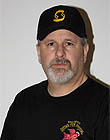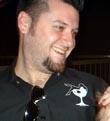|
|
This topic comprises 3 pages: 1 2 3
|
|
Author
|
Topic: Print Quality
|
|
|
|
|
|
|
|
|
|
|
|
|
|
|
|
|
|
|
|
|
|
|
|
|
Leo Enticknap
Film God

Posts: 7474
From: Loma Linda, CA
Registered: Jul 2000
|
 posted 01-30-2004 02:11 AM
posted 01-30-2004 02:11 AM





quote:
I've also seen "focusing telescopes" or binoculars used if the throw is long -- just be sure they are in focus too, maybe able to see the screen perforations.
I once did a few relief shifts at a small two-screen which had easily the longest throw of any cinema I ever worked at. Screen 2 was built at the rear of what was once a single auditorium. Screen 1's beam projected across a roof void over the top of the smaller auditorium, through a second port glass, and then across the main auditorium to the screen. I couldn't give you the exact throw, but you'll get some idea from the fact that the 1:1.85 lens was something like 165mm! I did have real problems focusing, simply because the screen was too far away for me to see it properly. So on the second weekend I bought a pair of binoculars with me. Problem sorted, and several of the staff there commented that the picture was sharper than they'd ever seen it!
quote:
As simple as focusing a lens sounds, it's really a skill that has to be developed. You have to develop the "eye" to know where to look on the screeen at any given moment to get the right focus.
Assuming that there are no heat issues with the projector and that all reels of the feature are printed on the same sort of stock you should not (in theory, at least) have to make any focus adjustments once a feature has started, if it's all running from one machine. One thing I found in a number of sites is that it's very important to strike the lamp a few minutes before showtime, otherwise expanding metal will cause the focus to drift during the first few minutes of the show. The same goes with 6,000 changeovers; with 2,000 changeovers I'd always leave both lamps running throughout the show.
When the feature starts, I would look for a reference point (not the opening censor certificate or distributor logo, which is often printed on separate stock from the actual film), set the focus, and then leave it unless there was something clearly not right. I also found that if there was a complaint arising from either a bad print or intentional soft focus effects, throwing the focus drastically out and then bringing it back slowly to where you started usually shuts 'em up.
During the changeover from acetate to polyester focusing could be living hell, because you'd often get a print with some reels on acetate and others on poly.
| IP: Logged
|
|
|
|
|
|
|
|
All times are Central (GMT -6:00)
|
This topic comprises 3 pages: 1 2 3
|
Powered by Infopop Corporation
UBB.classicTM
6.3.1.2
The Film-Tech Forums are designed for various members related to the cinema industry to express their opinions, viewpoints and testimonials on various products, services and events based upon speculation, personal knowledge and factual information through use, therefore all views represented here allow no liability upon the publishers of this web site and the owners of said views assume no liability for any ill will resulting from these postings. The posts made here are for educational as well as entertainment purposes and as such anyone viewing this portion of the website must accept these views as statements of the author of that opinion
and agrees to release the authors from any and all liability.
|

 Home
Home
 Products
Products
 Store
Store
 Forum
Forum
 Warehouse
Warehouse
 Contact Us
Contact Us




 Printer-friendly view of this topic
Printer-friendly view of this topic









![[thumbsup]](graemlins/thumbsup.gif)
![[Roll Eyes]](rolleyes.gif)


![[evil]](graemlins/evil.gif)

![[Wink]](wink.gif)



![[Big Grin]](biggrin.gif)
![[Frown]](frown.gif) )
)





